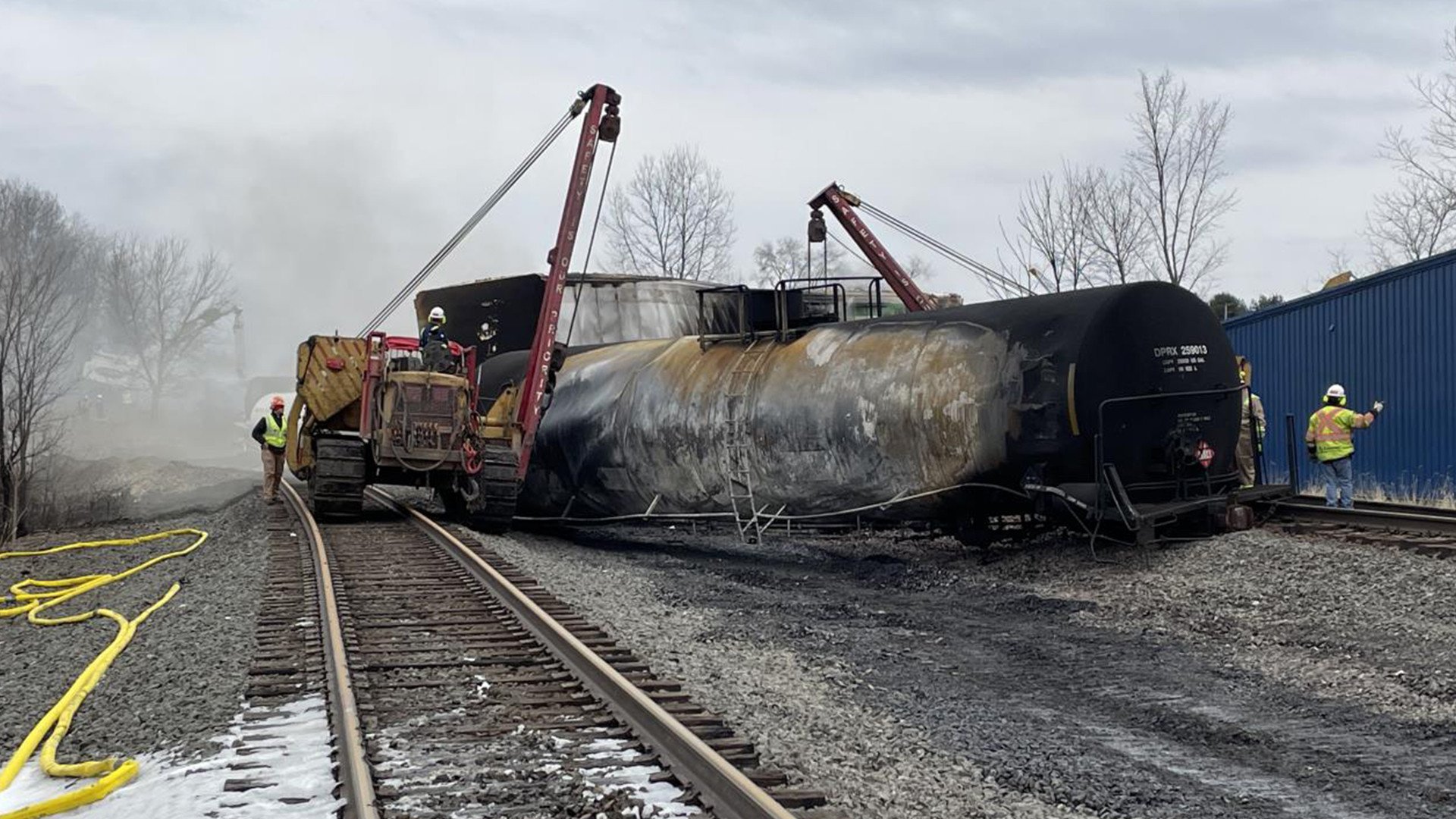Toxic Chemical Residue In Buildings Following Ohio Train Derailment

Table of Contents
The Spread of Toxic Chemicals
The Ohio train derailment involved the release of several hazardous substances, most notably vinyl chloride and butyl acrylate. These chemicals pose significant threats to human health and the environment.
Vinyl Chloride and Other Hazardous Substances
Vinyl chloride, a known carcinogen, can cause a range of health problems, including liver cancer, brain and lung tumors, and circulatory system disorders. Butyl acrylate, another released chemical, is an irritant that can affect the eyes, skin, and respiratory system. Exposure can lead to headaches, nausea, and breathing difficulties.
- Volatility and Long-Distance Transport: Both vinyl chloride and butyl acrylate are volatile organic compounds (VOCs), meaning they readily evaporate into the air. Wind patterns following the derailment played a crucial role in dispersing these chemicals over a wide area. Rainfall could have also facilitated their deposition onto surfaces, including building exteriors.
- Factors Influencing Spread: Several factors influenced the spread of these chemicals, including wind speed and direction, precipitation patterns, and the topography of the surrounding area. Studies utilizing chemical dispersal modeling are crucial in assessing the potential reach of the contamination.
Contamination Pathways
The chemicals released during the derailment could have reached buildings through various pathways:
- Air Deposition: Airborne chemicals settled on building surfaces, potentially contaminating the exterior and, depending on ventilation, the interior.
- Water Runoff: Rainfall could have washed the chemicals into drainage systems, potentially contaminating water sources and soil, which then could have impacted buildings near contaminated water sources.
- Soil Contamination: Soil near the derailment site became contaminated, and this contamination could potentially be tracked into buildings on shoes or other materials.
- Direct Contact: In the immediate vicinity of the derailment, direct contact with contaminated materials could have resulted in chemical residue on buildings. The persistence of these chemicals varies depending on the material. For example, porous materials like wood may absorb more chemicals than non-porous materials like concrete.
Health Risks Associated with Chemical Residue
Exposure to the chemicals released during the Ohio train derailment poses serious health risks, both acute and long-term.
Acute and Long-Term Health Impacts
Exposure can lead to a range of immediate and long-term health problems:
- Respiratory Issues: Irritation, coughing, shortness of breath, and more serious respiratory illnesses are possible.
- Skin Irritation: Direct contact can cause skin rashes, burns, or other irritations.
- Neurological Problems: Some chemicals can affect the nervous system, causing headaches, dizziness, or neurological disorders.
- Cancer Risks: Long-term exposure to carcinogens like vinyl chloride significantly increases the risk of various cancers.
Children and the elderly are particularly vulnerable to the effects of these chemicals. Independent studies are needed to fully assess the long-term effects of this exposure.
Symptoms and Testing
Individuals experiencing symptoms such as headaches, nausea, respiratory distress, skin irritation, or unusual fatigue after the derailment should seek medical attention immediately.
- Symptoms: Symptoms of chemical exposure vary depending on the chemical and the level of exposure. Immediate symptoms can include burning eyes, nose, and throat, as well as skin irritation. Long-term effects could appear years after exposure.
- Testing Methodologies: Testing for chemical residue in buildings typically involves air sampling, water testing, and soil analysis. Specialized laboratories can analyze samples to identify the presence and concentration of specific chemicals. Information on testing resources should be sought from local health authorities and environmental agencies.
Cleanup and Remediation Efforts
The cleanup and remediation efforts following the Ohio train derailment are extensive and ongoing.
Current State of Cleanup
Cleanup strategies involve several methods, including:
- Air Filtration: Specialized filters are used to remove airborne contaminants from buildings and the surrounding environment.
- Soil Removal: Contaminated soil is being excavated and disposed of properly.
- Decontamination of Buildings: Buildings showing signs of contamination may require thorough cleaning and decontamination procedures.
Government agencies, including the Environmental Protection Agency (EPA), are involved in overseeing and coordinating these efforts. However, challenges remain, including the widespread nature of the contamination and the potential for long-term effects.
Long-Term Monitoring and Prevention
Long-term monitoring and preventative measures are crucial to ensure the safety and well-being of the community.
- Ongoing Air and Water Quality Testing: Regular monitoring is needed to track the levels of contaminants in the air and water and to ensure the effectiveness of cleanup efforts.
- Improved Safety Regulations and Transportation Protocols: Stricter regulations are necessary to prevent similar incidents in the future. Improved transportation safety protocols for hazardous materials are critical.
- Community Engagement and Transparent Information Sharing: Open communication and transparency are essential to keep the community informed about the risks, cleanup progress, and long-term health monitoring.
Conclusion
The Ohio train derailment has raised significant concerns regarding toxic chemical residue in buildings, highlighting the urgent need for thorough investigation and remediation efforts. The potential health risks associated with exposure to these chemicals, particularly the long-term effects, demand immediate attention. Ongoing monitoring, transparent communication, and stricter safety regulations are crucial to mitigate the potential for future incidents and safeguard public health. Demand action from authorities to ensure a comprehensive and transparent cleanup, protecting the health and safety of the community. Seek information on available testing and resources to protect yourself and your family, stay informed about the latest developments, and advocate for stricter regulations to prevent future catastrophes. Demand accountability and transparency from all parties involved.

Featured Posts
-
 Thlathy Jdyd Fy Qaymt Mntkhb Amryka Llmrt Alawla Me Bwtshytynw
May 22, 2025
Thlathy Jdyd Fy Qaymt Mntkhb Amryka Llmrt Alawla Me Bwtshytynw
May 22, 2025 -
 Real Madrid Manager Search Klopps Agent Speaks Out
May 22, 2025
Real Madrid Manager Search Klopps Agent Speaks Out
May 22, 2025 -
 Malaysias Najib Faces New Allegations In French Submarine Bribery Probe
May 22, 2025
Malaysias Najib Faces New Allegations In French Submarine Bribery Probe
May 22, 2025 -
 Petite Italie De L Ouest Immersion Dans L Architecture Toscane
May 22, 2025
Petite Italie De L Ouest Immersion Dans L Architecture Toscane
May 22, 2025 -
 The Goldbergs Behind The Scenes Facts And Trivia You Didnt Know
May 22, 2025
The Goldbergs Behind The Scenes Facts And Trivia You Didnt Know
May 22, 2025
